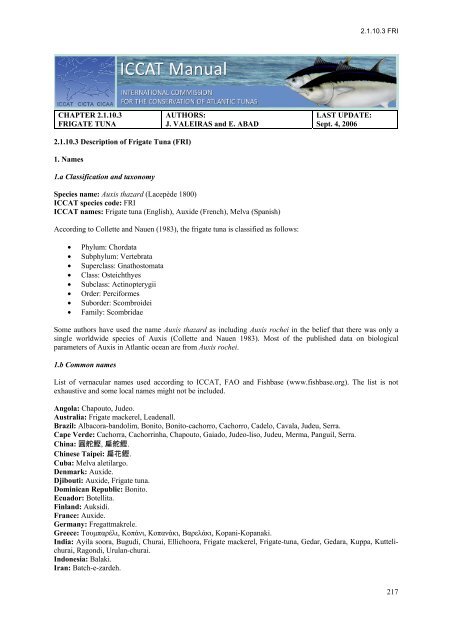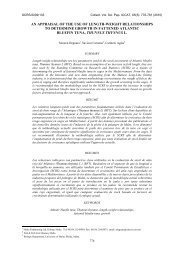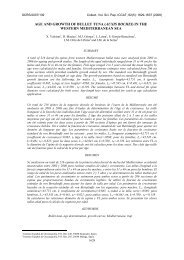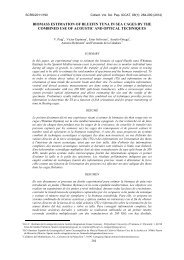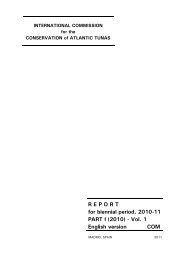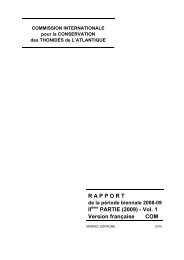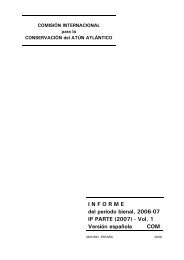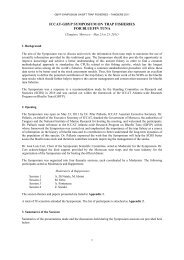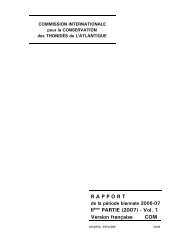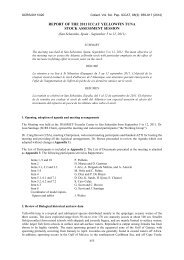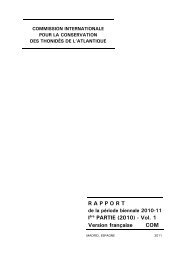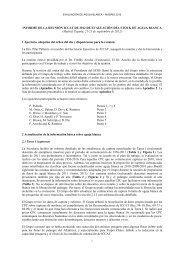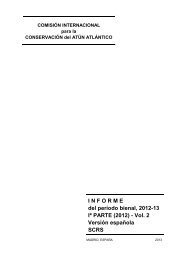Create successful ePaper yourself
Turn your PDF publications into a flip-book with our unique Google optimized e-Paper software.
CHAPTER 2.1.10.3<br />
FRIGATE TUNA<br />
2.1.10.3 Description of <strong>Frigate</strong> Tuna (FRI)<br />
1. Names<br />
1.a Classification and taxonomy<br />
AUTHORS:<br />
J. VALEIRAS and E. ABAD<br />
Species name: Auxis thazard (Lacepède 1800)<br />
ICCAT species code: FRI<br />
ICCAT names: <strong>Frigate</strong> <strong>tuna</strong> (English), Auxide (French), Melva (Spanish)<br />
According to Collette and Nauen (1983), the frigate <strong>tuna</strong> is classified as follows:<br />
• Phylum: Chordata<br />
• Subphylum: Vertebrata<br />
• Superclass: Gnathostomata<br />
• Class: Osteichthyes<br />
• Subclass: Actinopterygii<br />
• Order: Perciformes<br />
• Suborder: Scombroidei<br />
• Family: Scombridae<br />
LAST UPDATE:<br />
Sept. 4, 2006<br />
2.1.10.3 FRI<br />
Some authors have used the name Auxis thazard as including Auxis rochei in the belief that there was only a<br />
single worldwide species of Auxis (Collette and Nauen 1983). Most of the published data on biological<br />
parameters of Auxis in Atlantic ocean are from Auxis rochei.<br />
1.b Common names<br />
List of vernacular names used according to ICCAT, FAO and Fishbase (www.fishbase.org). The list is not<br />
exhaustive and some local names might not be included.<br />
Angola: Chapouto, Judeo.<br />
Australia: <strong>Frigate</strong> mackerel, Leadenall.<br />
Brazil: Albacora-bandolim, Bonito, Bonito-cachorro, Cachorro, Cadelo, Cavala, Judeu, Serra.<br />
Cape Verde: Cachorra, Cachorrinha, Chapouto, Gaiado, Judeo-liso, Judeu, Merma, Panguil, Serra.<br />
China: , .<br />
Chinese Taipei: .<br />
Cuba: Melva aletilargo.<br />
Denmark: Auxide.<br />
Djibouti: Auxide, <strong>Frigate</strong> <strong>tuna</strong>.<br />
Dominican Republic: Bonito.<br />
Ecuador: Botellita.<br />
Finland: Auksidi.<br />
France: Auxide.<br />
Germany: Fregattmakrele.<br />
Greece: , , , , Kopani-Kopanaki.<br />
India: Ayila soora, Bugudi, Churai, Ellichoora, <strong>Frigate</strong> mackerel, <strong>Frigate</strong>-<strong>tuna</strong>, Gedar, Gedara, Kuppa, Kuttelichurai,<br />
Ragondi, Urulan-churai.<br />
Indonesia: Balaki.<br />
Iran: Batch-e-zardeh.<br />
217
ICCAT MANUAL, 1st Edition (January 2010)<br />
Italy: Mpisu, Biso, Bisu, Bonitu, Culariau, Istrumbu, Istrumbulu, Motolo, Motulu, Muetolo, Pisantuni,<br />
Pizzutellu, Sangusu, Scurmo, Scurmu, Sgamirru, Sgamiru, Sgionfeto, Strumbo, Strumbu, Strumbulu,<br />
Strummulu, Tambarela, Tambarello, Tambarelo, Tamburello, Tombarello, Tonnetto, Tumbarello, Tunnacchiu.<br />
Japan: Hiramejika, Hirasoda, Hirasôda, Hirasodakatsuo, Oboso, Obosogatsuwo, Shibuwa, Soda-gatsuo, Soma,<br />
Suma.<br />
Malaysia: Aya, Aya selaseh, Baculan, Bakulan, Kayau, Kayu, Selasih, Tongkol, Tongkol selasih.<br />
Martinique: Bonit queue raide.<br />
Mexico: Barrilete negro, Bonito, Melva.<br />
Micronesia: Mackerel <strong>tuna</strong>, Yasiuneiu-yauma.<br />
Mozambique: Judeu.<br />
Netherlands: Fregatmakreel.<br />
New Zealand: <strong>Frigate</strong> <strong>tuna</strong>.<br />
Nicaragua: Melva.<br />
Norway: Auxid.<br />
Oman: Deraiga, Sadah, Tibban.<br />
Papua New Guinea: <strong>Frigate</strong> mackerel, <strong>Frigate</strong> <strong>tuna</strong>.<br />
Peru: Barrileto negro.<br />
Philippines: Aloy, Budburon, Buroboto, Ehalason, <strong>Frigate</strong> <strong>tuna</strong>, Ilahason, Kantorayan, Mangko, Mangkoh,<br />
Perit, Pidlayan, Pirit, Super Aloy, Tangi, Tolingan, Tulingan, Tulingan lapad, Vahuyo.<br />
Poland: Tazar.<br />
Portugal: Judeu, Judeu-liso e judeu.<br />
Romania: Melva, Ton negru.<br />
Sao Tome Prn: Fulu fulu.<br />
Somalia: Jaydar-dhiiglow.<br />
Spain: Melva.<br />
St Helena: Mackerel <strong>tuna</strong>.<br />
Sweden: Auxid.<br />
Tanzania: Sehewa.<br />
Trinidad Tobago: Bonito.<br />
Turkey: Gobene, Tombile.<br />
United Arabian Emirates: Tabban<br />
United Kingdom: <strong>Frigate</strong> <strong>tuna</strong>.<br />
United States of America: Bullet mackerel, <strong>Frigate</strong> mackerel, <strong>Frigate</strong> <strong>tuna</strong>.<br />
Venezuela: Cabaña negra.<br />
Vietnam: Cá Ngùr chù, <strong>Frigate</strong> mackerel.<br />
2. Identification<br />
Figure 1. Drawing of an adult Auxis thazard (by A. López, ‘Tokio’).<br />
218
Characteristics of Auxis thazard (see Figure 1 and Figure 2)<br />
2.1.10.3 FRI<br />
<strong>Frigate</strong> <strong>tuna</strong> is a small <strong>tuna</strong> species. Maximum size is 65 cm (Cayré et al. 1993). Common size is 25 to 40 cm<br />
depending on fishing gear, seasonally and region (Collete and Nauen 1983; Collete 1986).<br />
Colour:<br />
• Colour bluish on dorsal parts turning to deep purple or almost black on the head.<br />
• Pattern of 15 or more dark bars or wavy lines, oblique to nearly horizontal, in the scaleless area above<br />
lateral line.<br />
• White belly without stripes or spots.<br />
• Pectoral and pelvic fins are purple, with black inner sides.<br />
External:<br />
• Body robust elongate and rounded.<br />
• Body naked, except for the corselet which is well developed. Corselet narrow in its posterior part (no<br />
more than 5 scales wide under second dorsal fin origin).<br />
• Strong median keel on each side of caudal peduncle, between two smaller keels.<br />
• Two dorsal fins separated by a large interspace (at least equal to length of first dorsal fin base). Second<br />
dorsal lower than first, followed by 8 finlets.<br />
• Anal fin followed by 7 finlets.<br />
• Short pectoral fin but extending posterior to beginning scaleless area above corselet. Pectoral rays: 22-<br />
25.<br />
• Dorsal spines: 10-12.<br />
• Gillrakers on first arch: 38-47.<br />
• Inter-pelvic process single and very large, equal to length of pelvic fins.<br />
Internal:<br />
• Swimbladder absent.<br />
• Right lobe of liver very long, extending the length of the body cavity and left lobe greatly reduced.<br />
• Vertebrae: 39.<br />
• Cutaneus artery present but divided into separate dorsal and ventral branches. The ventral branch is<br />
very poorly developed.<br />
Short pectoral fin but extending<br />
posterior to beginning scaleless<br />
area above corselet. Pectoral rays:<br />
22-25<br />
Pattern of 15 or more dark bars or wavy<br />
lines, oblique to nearly horizontal, in the<br />
scaleless area above lateral line<br />
Strong median keel on each<br />
side of caudal peduncle,<br />
between two smaller keels<br />
Figure 2. Synthesis of the most outstanding characteristics of Auxis thazard (by A. López, ‘Tokio’).<br />
219
ICCAT MANUAL, 1st Edition (January 2010)<br />
3. Distribution and population ecology<br />
3.a Geographical distribution<br />
The genus Auxis is distributed worldwide in tropical and subtropical waters. The confusion surrounding the<br />
identification of the species of Auxis is reflected in their reported distribution in the world’s oceans. Auxis is<br />
distributed in both sides of the tropical and subtropical Atlantic Ocean, including the Mediterranean, Caribbean<br />
Sea and Gulf of Mexico (Figure 3). Latitudinal range reported for genus in Atlantic is from 45ºN to 35ºS.<br />
In the eastern Atlantic is reported as far north as Norway and as far south as South Africa waters. In the western<br />
Atlantic off the east coast of North America has been recorded from Gulf of Maine, (Cape Cod). Off the Atlantic<br />
coast of South America the species is recorded to Mar del Plata (Argentina).<br />
Figure 3. Geographical distribution of Auxis sp. (FAO. c2001-2009. Compilation of aquatic species distribution<br />
maps of interest to fisheries. In FAO Fisheries Department [online]. Rome. [15 sept. 2009].<br />
http://www.fao.org/fishery/collection/fish_dist_map).<br />
3.b Habitat preferences<br />
<strong>Frigate</strong> <strong>tuna</strong> is an epipelagic and neritic fish as well as oceanic occurring in warm waters. Larvae have a high<br />
temperature tolerance of at least 21.6 to 30.5ºC, (the widest among <strong>tuna</strong> species studied), their optimum is 27-<br />
27.9ºC.<br />
The species has a strong schooling behaviour.<br />
3.c Migrations<br />
Little is known about frigate <strong>tuna</strong> movements. Less migratory than other <strong>tuna</strong> species.<br />
3.d Recruitment<br />
Knowledge of the early life stages in <strong>tuna</strong>s is very scarce. It is assumed that larval period is short. During the<br />
first life stages frigate <strong>tuna</strong> are not caught and juvenile life history is unknown. Immature fish first appear in<br />
fishery from around 25 cm of fork length.<br />
220
4. Biology<br />
4.a Growth<br />
2.1.10.3 FRI<br />
Most of the studies on growth of Auxis species in Atlantic regards to Auxis rochei. Data of Auxis thazard from<br />
Gibraltar Straits area published by Rodriguez-Roda (1966) were later attributed to Auxis rochei for the same<br />
author (Rodriguez-Roda 1983).<br />
Table 1. Growth parameters for frigate <strong>tuna</strong> (L in cm, K in y-1, t0 in y).<br />
L<br />
Growth Parameter<br />
k t0 Area Reference<br />
N Method<br />
51.47 0.32 -0.83 Eastern Central Atlantic Grudtsev and Korolevich, 1986. 237 Spines<br />
51.5 1 - West Java, Indonesia Dwiponggo et al., 1986<br />
4.b Length-Weight relationship<br />
Most of the studies on length-weight relationships of Auxis species in Atlantic regards to Auxis rochei. Data of<br />
Auxis thazard from Gibraltar Straits area published by Rodriguez-Roda (1966) were latter attributed to Auxis<br />
rochei for the same author (Rodriguez-Roda, 1983). Probably, the relationship for A. thazard published by<br />
Ramos et al. (1985) refers also to A. rochei.<br />
Table 2. Published frigate <strong>tuna</strong> length-weight relationships.<br />
Equation N Area Country Reference<br />
W= 0.00166 x FL 3.64257<br />
515 Gibraltar Strait Spain Ramos et al., 1985<br />
W= 0.0547x FL 2.7<br />
- South Africa van der Elst, 1981<br />
W= 0.01x FL 3.13<br />
- Southwestern Brazil Brazil Madureira and Rossi-Wongtschowski, 2005<br />
W= 0.0061x FL 3.3<br />
- Mikomoto Japan Ishida, 1971<br />
W= 0.077 x FL 2.509<br />
- Shionomisaki Japan Ishida, 1971<br />
W= 0.0018x FL 3.334<br />
- Sri Lanka Sivasubramaniam, 1966<br />
4.c Reproduction<br />
Most of the studies on reproduction of Auxis species in Atlantic regards to Auxis rochei. Some information for<br />
other oceans are included below.<br />
Spawning<br />
The species has an extended spawning period from February to November depending on the geographical area in<br />
North Atlantic. In tropical African coasts the spawning occurs from April to September off Sierra Leone, in<br />
summer in the gulf of Guinea, November and December off Congo and Angola (Rudomiotkina 1984). Spawning<br />
is recorded at the surface water temperatures of 21.6-30.5º, with massive spawning at 25-26º.<br />
Maturity<br />
Sexual maturity is reached at about 29 cm fork length in Japanese waters and 35 c around Hawai (Collette and<br />
Nauen 1983).<br />
Fecundity<br />
Fecundity was estimated at about 1.37 million eggs per year in a 44.2 cm female. Fecundity of fish in Indian<br />
waters ranged between approximately 200,000 to 1.06 million eggs per spawning in correlation with the size of<br />
females (Collette and Nauen 1983).<br />
221
ICCAT MANUAL, 1st Edition (January 2010)<br />
4.d First life stages<br />
Eggs and larvae<br />
Eggs are pelagic, 0.84-0.92 mm of diameter and with one oil globule (0.24-0.29 mm of diameter). The yolk is<br />
homogeneus. The hatch size is 2.32 mm. The embryo presents melanophores and large green chromatophores on<br />
posterior half. Larvae present pigmentation on midbrain, hindbrain, gut, cleithral symphysis dorsal, lateral and<br />
ventral margins of tail (Richards 2005).<br />
4.e Diet<br />
Food is primarily selected by the size of gillrakers. The species feeds on fish, crustaceans, cephalopods and<br />
others. Fish prey largely of small pelagic fishes, particularly anchovies and other clupeoids (Etchevers 1957).<br />
Crustaceans are especially planktonic crustaceans as megalops and stomatopods larvae.<br />
Predators: several <strong>tuna</strong> species, pelagic sharks, billfishes and big pelagic fish (Coryphaena hippurus, Alepisaurus<br />
sp, Sphyraena sp.). Because of its abundance, they are considered an important element of the food chain, being<br />
a forage prey for other commercial species (Olson 1982).<br />
4.f Physiology<br />
There is a lack on information on this topic.<br />
4.g Behaviour<br />
Little is known about little <strong>tuna</strong> behaviour patterns.<br />
4.h Natural mortality<br />
There is a lack on information available on this biological parameter.<br />
5. Fisheries biology<br />
5.a Populations/Stock structure<br />
There is little information available to determine the stock structure of frigate <strong>tuna</strong>. Current information does not<br />
allow for an evaluation of stock status.<br />
5.b Description of fisheries: catches and effort<br />
<strong>Frigate</strong> <strong>tuna</strong> is exploited mainly by surface gears and artisanal fisheries as trolling lines, handlines, small-scale<br />
longlines, and a wide variety of nets, especially traps, gill or drift nets, ring nets, beach seines, otter trawls, and<br />
purse seines. In some of these fisheries, Auxis species are taken incidentally as by-catch as in purse seine<br />
fisheries for yellowfin and skipjack <strong>tuna</strong>.<br />
In the Atlantic, catches of Auxis species are usually not identified to species. Thus in the total catch of frigate<br />
<strong>tuna</strong>, the proportion of each of the two species is not known. However, almost the entire Venezuela, Atlantic and<br />
Mediterranean catch is supposedly Auxis rochei (Collette and Nauen 1983).<br />
Annual catches reach 25,903 t in 1988 (Figure 4). Average estimated landings from 1980 to 2004 is 16,649 t.<br />
Unknown quantities of bullet <strong>tuna</strong> are landing and recorded as frigate <strong>tuna</strong> in the Atlantic (ICCAT 2006).<br />
222
30000<br />
25000<br />
20000<br />
15000<br />
10000<br />
5000<br />
0<br />
1980<br />
1981<br />
Figure 4. Catch (t) distribution of frigate <strong>tuna</strong> in the Atlantic Ocean and Mediterranean Sea, 1980-2004.<br />
6. Bibliography<br />
1982<br />
1983<br />
1984<br />
1985<br />
1986<br />
1987<br />
1988<br />
1989<br />
1990<br />
1991<br />
1992<br />
2.1.10.3 FRI<br />
CAYRÉ, P., J. B. Amon Kothias, T. Diouf and J. M. Stretta, 1993 Biology of <strong>tuna</strong>. p. 147-244. In A. Fonteneau<br />
and J. Marcille (eds.) Resources, fishing and biology of the tropical <strong>tuna</strong>s of the Eastern Central Atlantic.<br />
FAO Fish. Tech. Pap. 292. Rome, FAO. 354 p.<br />
COLLETE, B. B., 1986. Scombridae. In: P.J.P. Whitehead, M.-L. Bauchot, J.-C. Hureau, J. Nielsen, and E.<br />
Tortonese (eds.), Fishes of the North-eastern Atlantic and the Mediterranea. Vol II. pp. 981-997. Unesco,<br />
Paris.<br />
COLLETTE, B. B. and C. E. Nauen, 1983. FAO species catalogue. Vol. 2. Scombrids of the world. An<br />
annotated and illustrated catalogue of <strong>tuna</strong>s, mackerels, bonitos and related species known to date. FAO<br />
Fish. Synop. 125(2). 137 pp.<br />
DWIPONGGO, A., T. Hariati, S. Banon, M. L. Palomares and D. Pauly, 1986. Growth, mortality and<br />
recruitment of commercially important fishes and penaeid shrimps in Indonesian waters. ICLARM Tech.<br />
Rep. 17, 91 p.<br />
ETCHEVERS, S. L., 1976. Incidencia de clupeoideos en la alimentacion de las caballas: Euthynnus alletteratus<br />
(Rafinesque 1976) y Auxis thazard (Lacepède) en la costa noreste de Margarita. Lagena, (37-38):9-11.<br />
GRUDTSEV M. E. and L. I. Korolevich, 1986. Studies of frigate <strong>tuna</strong> Auxis thazard (Lacepede) age and growth<br />
in the eastern part of the Equatorial Atlantic. Col. Vol. Sci. Pap. ICCAT, 25(2): 269-274.<br />
ICCAT. 2006. Report for biennial period, 2004-05 Part II (2005) - Vol. 2, Executive Summaries on Species:<br />
Small Tunas: 128-135.<br />
ISHIDA, Y. 1971. Investigation of frigate mackerel (Auxis rochei), 1968 season. (In Jap.) Rep. Kochi Pref. Fish.<br />
Expo. Stn 66 and 67: 119-140.<br />
MADUREIRA, L. S. P. and C. L. D. B. Rossi-Wongtschowski (Editors), 2005. Prospecção de recursos<br />
pesqueiros pelágicos na Zona Econômica Exclusiva da Região Sudeste-Sul do Brasil: hidroacústica e<br />
biomassas. Série documentos Revizee: Score Sul, Instituto Oceanográfico, USP, São Paulo, Brazil. 144 p.<br />
OLSON, R. J. 1982. Feeding and energetics studies of yellowfin <strong>tuna</strong>; food for ecological thought. Col. Vol. Sci.<br />
Pap. ICCAT, 17:444-57.<br />
RAMOS, A., A lot, E., and J. A. Camiñas, 1985. Relación talla/peso de la melva, Auxis thazard, para el<br />
Atlántico y Mediterráneo. Collect. Vol. Sci. Pap. ICCAT, 25: 265-268 (1986).<br />
RICHARDS, W.J., (ed.). 2005. Early Stages of Atlantic Fishes: An identification guide for the western central<br />
North Atlantic. CRC Press, Taylor and Francis Group, Boca Raton, FL, 2640 pp.<br />
RODRÍGUEZ-RODA, J. 1966. Estudio de la bacoreta, Euthynnus alletteratus (Raf.), bonito, Sarda sarda<br />
(Bloch) y melva Auxis thazard (Lac.), capturados por las almadrabas españolas. Invest. Pesq. 30: 247-292.<br />
RODRIGUEZ-RODA J. 1983. Edad y crecimiento de la melva, Auxis rochei (Risso), del Sur de España. Invest.<br />
Pesq. (Barc.), 47(3): 397-402.<br />
Year<br />
FRI_Med FRI_Atl FRI_Total<br />
1993<br />
1994<br />
1995<br />
1996<br />
1997<br />
1998<br />
1999<br />
2000<br />
2001<br />
2002<br />
2003<br />
2004<br />
223
ICCAT MANUAL, 1st Edition (January 2010)<br />
RUDOMIOTKINA, G. P. 1984. New data on reproduction of Auxis spp. In the Gulf of Guinea. Collect. Vol. Sci.<br />
Pap. ICCAT, 20(2): 465-468.<br />
SIVASUBRAMANIAM, K. 1966. Distribution and length-weight relationships of <strong>tuna</strong>s and <strong>tuna</strong>-like fishes<br />
around Ceylon. Bull. Fish. Res. Stn. Ceylon, 19:27-46.<br />
VAN DER ELST, R. 1981. A guide to the common sea fishes of southern Africa. C. Struik, Cape Town. 367 p.<br />
224


